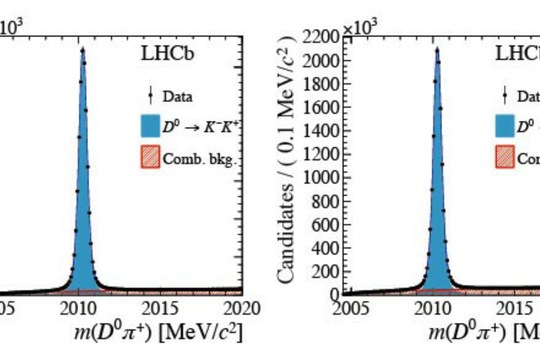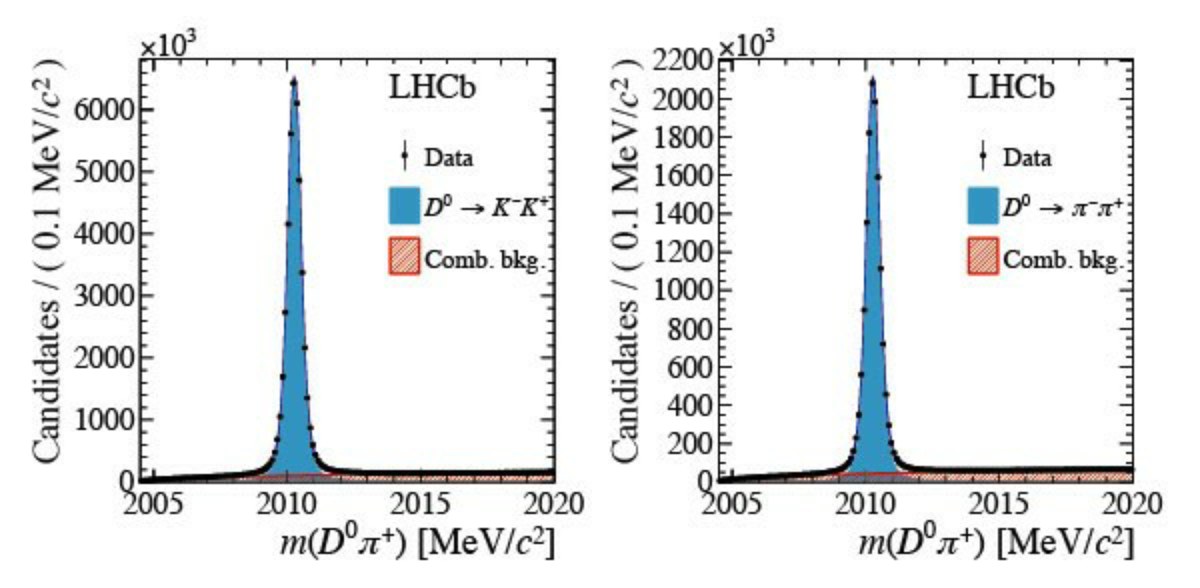
Discovery of CP violation in charm decays
The LHCb collaboration set an important milestone in the history of particle physics: CP violation was observed for the first time in the decay of particles containing a charm quark
Pubblicato: 27 novembre 2019 | Innovazione e ricerca

.
https://doi.org/10.1103/PhysRevLett.122.211803
Link: http://lhcb-public.web.cern.ch/lhcb-public/Welcome.html#CPVcharm
Authors/Autori: Dr. Federico Betti (DIFA e INFN), Prof. Angelo Carbone (DIFA e INFN), Dr. Fabio Ferrari (DIFA e INFN), Dr. Stefano Perazzini (INFN), Dr. Vincenzo Vagnoni (INFN).
The LHCb Collaboration measured, for the first time ever, that the probability of the so-called D 0 (a composite particle composed of a charm quark and an up antiquark) to decay in two kaons or two pions (particles composed by up, down and strange quarks and antiquarks) is different from that of the corresponding antiparticle, the D0, to decay in the same way. This phenomenon, known as charge-parity (CP) violation, was never seen so far when dealing with charm quarks.
The measurement consists in reconstructing and counting the D0 and D0 mesons decays into pairs of kaons or pions. The unprecedented yields of such charm decays present in the data sample collected by LHCb between 2011 and 2018, amounting to several tens of millions, allowed the asymmetry between the number of D0 and D0 decays to be measured with a precision that was never reached before, of the order of 10-4. The final result, equal to the difference between the asymmetries measured in the two decay modes D0 → K-K+ and D0 → π-π+ is ΔACP = (-15.4 ± 2.9) x 10-4, which is statistically different from 0 by 5.3 standard deviations, exceeding the threshold of 5 standard deviations adopted to claim a discovery.
The existence of CP violation in the decay of charm particles is something predicted by the Standard Model (SM) of the particle physics and it has been searched for by several experiments since decades. Unfortunately, theoretical calculations of the size of CP violation in charm particles are difficult to perform, and we cannot tell at the moment if what we measured is quantitatively compatible with the SM for sure or there are new physics processes at play. This measurement will help put further constraints on theoretical calculations, and, more important, it opens a new avenue in particle physics: the study of CP-violating effects in the sector of up-type quarks. This is uncharted territory in the search for the long-sought sources of matter-antimatter asymmetry needed to explain our universe: note indeed that, so far, CP violation has been observed only in the sector of down-type quarks, namely in the 1964 measuring the decay of a meson made of strange quark (K0s) by an experiment lead by the Nobel prizes J. Cronin and V. Fitch and in the 2001, by the BaBar and Belle Collaborations observing the decay of a meson made of a beauty quark (B0).

Invariant mass distributions for the D*+→ D0(K+K-)π+ and D*+→ D0(π+π-)π+ decays with the results of the fits superimposed.
Scoperta di violazione di CP nei decadimenti del charm
La collaborazione LHCb ha realizzato un’importante misura, che può essere considerata una pietra miliare per la storia della fisica delle particelle elementari: la violazione di CP è stata osservata per la prima volta nel decadimento di particelle contenenti il quark charm. Questo rappresenta un ulteriore passo verso la comprensione della asimmetria materia-antimateria presente nell’Universo.
La Collaborazione LHCb ha misurato per la prima volta che la probabilità del mesone D0 (particella composita composta da un quark charm e un antiquark up) di decadere in due kaoni o due pioni (particelle composte da quark e antiquark up, down e strange) è diversa da quella della corrispondente antiparticella, il mesone D0. Questo fenomeno, noto come violazione della carica-parità (CP), non è mai stato osservato nei decadimenti delle particelle contenti il quark charm.
La misurazione consiste nel ricostruire e contare i decadimenti dei mesoni D0 e D0 in coppie di kaoni o pioni. Il campione di dati raccolti da LHCb tra il 2011 e il 2018 è costituito da un numero senza precedenti di questi mesoni, pari a diverse decine di milioni. Grazie a questa statistica è stato possibile misurare l'asimmetria tra il numero di decadimenti D0 e D0 con una precisione mai raggiunta prima, dell'ordine di 10-4. Il risultato finale, pari alla differenza tra le asimmetrie misurate nei due modi di decadimento D0 → K-K+ e D0 → π-π+ è ΔACP = (-15.4 ± 2.9) x 10-4. Tale valore, statisticamente diverso da 0 per 5.3 deviazioni standard, supera la soglia di 5 deviazioni standard solitamente considerata sufficiente per rivendicare una scoperta. Pertanto, tale misura, rappresenta la prima osservazione di violazione di CP nei mesoni contenti il quark charm.
L'esistenza di questo tipo di violazione di CP è prevista dal Modello Standard (SM) della fisica delle particelle ed è stata investigata da diversi esperimenti per decenni e finalmente osservata da LHCb. Sfortunatamente, i calcoli teorici di questa quantità sono difficili da eseguire, e non possiamo dire al momento se ciò che è stato misurato è quantitativamente compatibile con il SM o se è dovuto a Nuova Fisica. Questa misura aiuterà a porre ulteriori vincoli sui calcoli teorici e, cosa più importante, aprirà una nuova strada nella fisica delle particelle: lo studio degli effetti di violazione della CP nel settore dei quark di tipo up. Questo è un territorio inesplorato nella ricerca delle origini di asimmetria tra materia e antimateria del nostro Universo, infatti finora la violazione di CP era stata osservata solo nel settore dei quark di tipo down, precisamente nel 1964 nell’esperimento condotto da J. Cronin e V. Fitch nei mesoni contenenti il quark strange (K0s) e dalle Collaborazioni BaBar e Belle nel 2001 nel mesone contenente il quark beauty (B0).